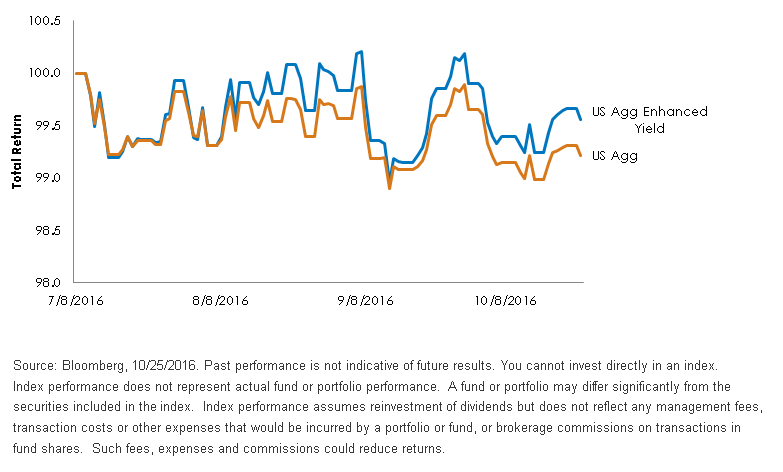U.S. Fixed Income: Going to the Core


With the Federal Reserve (Fed) “back in play” in the money and bond markets, investors are discussing rising rates once again. As one looks back over the last three to four months, it is interesting to note that U.S. Treasury (UST) yields—specifically, for the 10-Year note—have already moved off their summertime lows, despite no official policy action from the Fed. Against this backdrop, we feel it is prudent to examine how core fixed income strategies have performed in this environment.
When analyzing the impact of rising Treasury yields, studies often examine prior years of interest rate increases. However, given the magnitude of the rise in the 10-Year Treasury yield in recent months, one does not need to conduct a historical analysis. Indeed, a clear-cut case of rising rates has just occurred right before our eyes, and it occurred when events that surround the fixed income arena have profound relevance. In other words, the increase transpired against a backdrop that investors will likely continue to confront in the future—that is, potential Fed tightening, moderate economic growth at best, low inflation, occasional bouts of safe-haven demand and, of course, historically low developed sovereign debt yields abroad. And lest we forget, this is a U.S. presidential election year, and the outcome could very well have lasting effects well after the final votes are in.
Bloomberg Barclays U.S. Aggregate Enhanced Yield Index vs. Bloomberg Barclays U.S. Aggregate Index (Agg)

Our case study begins on July 8 of this year, the day the UST 10-Year yield hit its all-time low of 1.36%. Since then, the UST 10-Year yield has risen more than 40 basis points (bps) as of this writing, hovering right around the 1.80% threshold. An increase of this magnitude certainly qualifies as a “rising rate event” and underscores the need for investors to carefully consider how their core fixed income positions are situated.
In our opinion, a disciplined approach for core fixed income is a key part of portfolio strategy. The primary focus should be on the relative value differentials that exist within the investment grade (IG) universe—in other words, reallocating positions among the interest and credit-sensitive arenas. One of the most closely followed bond indexes in the world is the Bloomberg Barclays U.S. Aggregate Index, known as the Agg. Because of the surge in government debt in recent years, this market cap-weighted index tilts a larger weighting toward U.S. Treasuries, which can reduce income potential in a low rate environment and can leave investors more susceptible to increases in interest rates.
A strategy to help address these issues can be found in the Bloomberg Barclays U.S. Aggregate Enhanced Yield Index. Subject to a series of constraints, this index reweights the components of the Agg, which results in an under-weight to Treasuries and a higher allocation to investment-grade corporates. Not only has the IG sector provided a visible yield advantage to Treasuries, it can also offer some risk mitigation from rising rates if the economy improves.
During this recent back-up in the UST 10-Year yield, the graph above illustrates how the Bloomberg Barclays U.S. Aggregate Enhanced Yield Index helped to mitigate interest rate risk and outperformed the Agg by roughly .35% as of this writing. A key factor behind this outperformance was the elevated exposure to IG corporates. Indeed, since the early July nadir in the UST 10-Year yield, IG spreads narrowed by more than 20 bps, helping to offset the visible rise in rates.
Conclusion
In a relatively low and range-bound interest rate environment (one that can include rate increases, as well), investors should examine the core fixed income aspect of their portfolio and balance the need for income potential and lessening rate risk where possible. The WisdomTree Barclays U.S. Aggregate Bond Enhanced Yield Fund (AGGY), which tracks the Bloomberg Barclays U.S. Aggregate Enhanced Yield Index, offers investors a solution on both fronts.
Unless otherwise noted, data source is Bloomberg, as of 10/24/16.
Important Risks Related to this Article
Fixed income investments are subject to interest rate risk; their value will normally decline as interest rates rise. In addition, when interest rates fall, income may decline. Fixed income investments are also subject to credit risk, the risk that the issuer of a bond will fail to pay interest and principal in a timely manner or that negative perceptions of the issuer’s ability to make such payments will cause the price of that bond to decline.
There are risks associated with investing, including possible loss of principal. Fixed income investments are subject to interest rate risk; their value will normally decline as interest rates rise. Fixed income investments are also subject to credit risk, the risk that the issuer of a bond will fail to pay interest and principal in a timely manner, or that negative perceptions of the issuer’s ability to make such payments will cause the price of that bond to decline. Investing in mortgage- and asset-backed securities involves interest rate, credit, valuation, extension and liquidity risks and the risk that payments on the underlying assets are delayed, prepaid, subordinated or defaulted on. Due to the investment strategy of the Fund, it may make higher capital gain distributions than other ETFs. Please read the Fund’s prospectus for specific details regarding the Fund’s risk profile.


